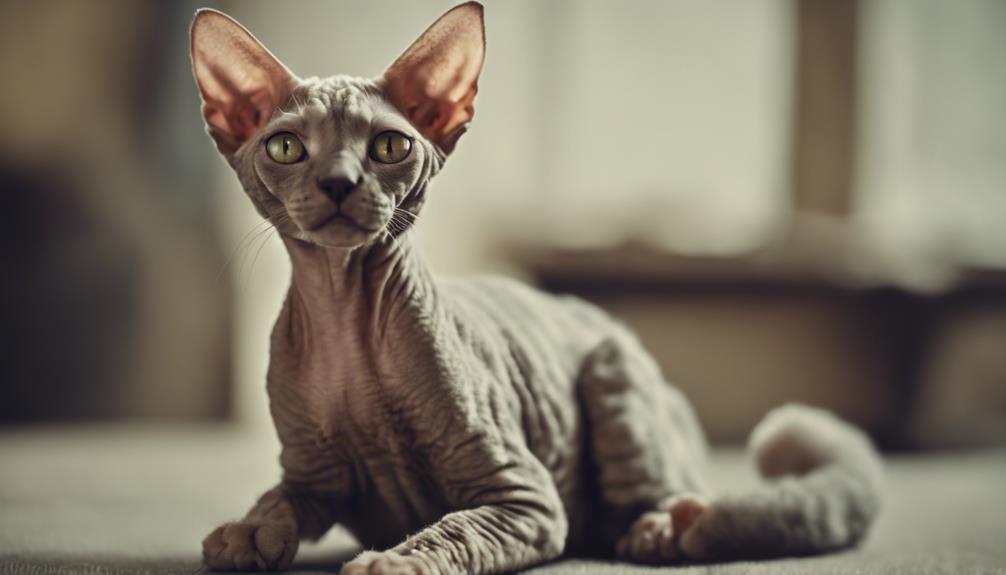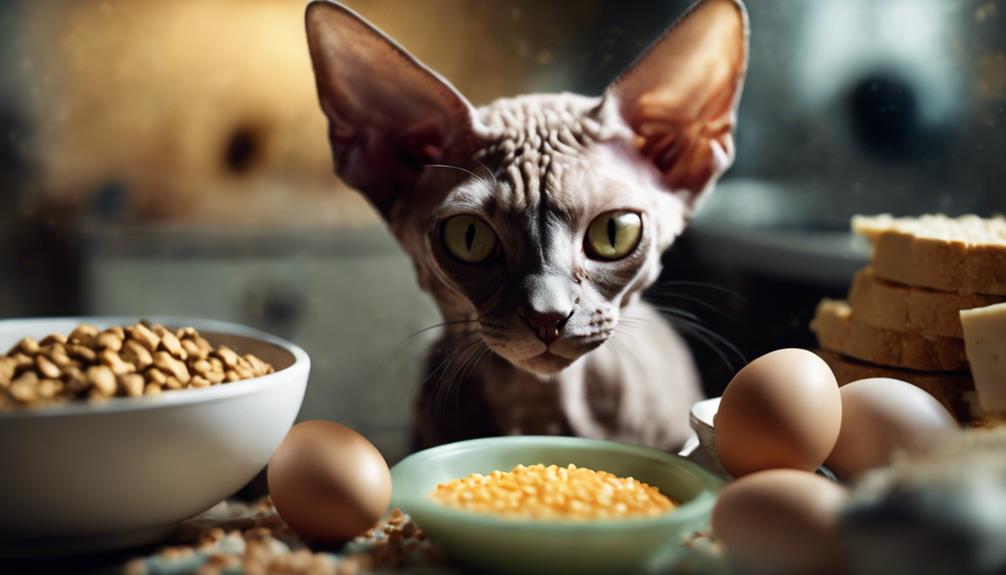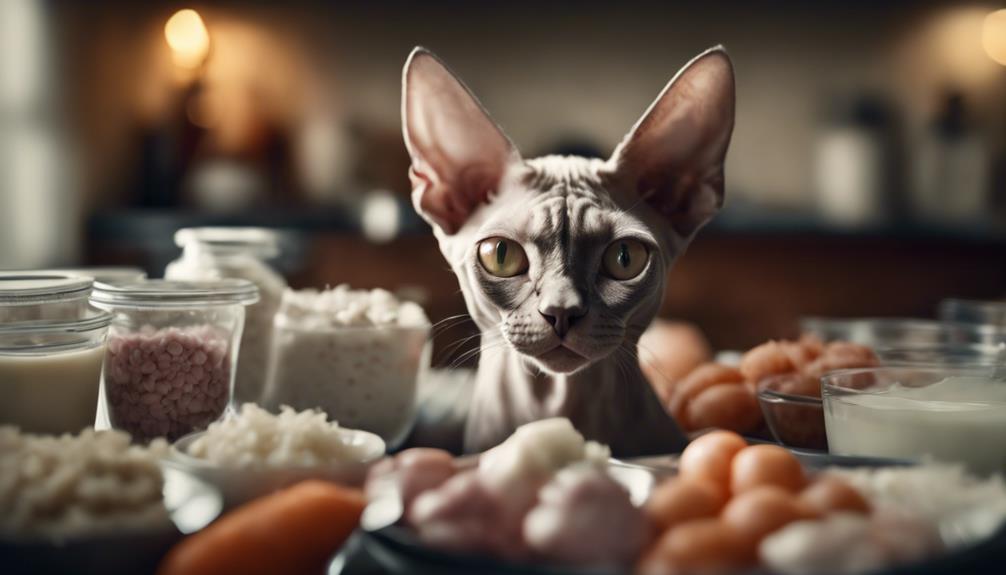As I explore the fascinating realm of Devon Rex breed evolution, one compelling statistic stands out: the genetic mutation in Devon, England in 1960 that sparked the creation of this unique feline lineage.
Understanding the intricacies of how this breed has evolved over time can shed light on their enchanting characteristics and distinctive behaviors. By unraveling the layers of their genetic history and tracing the path of their development, we can gain valuable insights into the complex journey that has shaped the Devon Rex into the beloved companion it is today.
Key Takeaways
- Genetic mutations in Devon, England sparked Devon Rex’s evolution.
- Selective breeding programs shaped distinctive physical and behavioral traits.
- Crossbreeding efforts ensured genetic diversity and breed advancement.
- Future trends include genetic testing, selective breeding, and DNA analysis for enhanced understanding.
Devon Rex Breed Origins
In the 1960s, the Devon Rex breed sprang forth from a genetic anomaly discovered by Beryl Cox in a feral cat litter in Devon, England. This chance discovery led to the establishment of the unique breed we know today.
Initially, there was confusion surrounding its relation to the Cornish Rex breed due to similar physical characteristics. However, breeding attempts between the two failed to produce curly-coated kittens, confirming they were distinct breeds. Further studies delving into coat genetics solidified the Devon Rex and Cornish Rex as separate entities with no shared lineage.
Understanding the origins of the Devon Rex sheds light on the pivotal role Beryl Cox played in uncovering this fascinating genetic mutation that gave rise to a beloved cat breed.
Historical Influences on Devon Rex
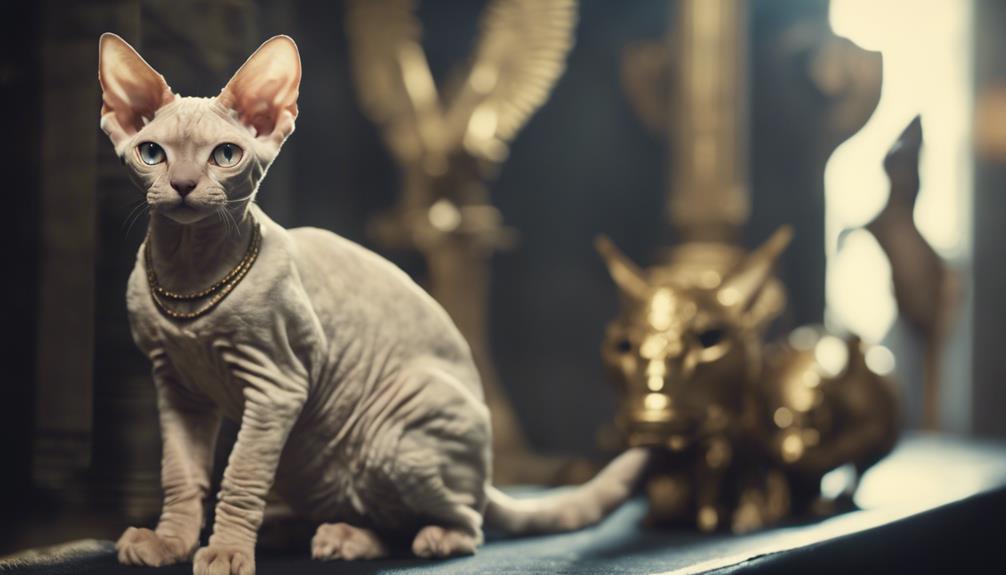
I’ll start by examining the breed’s origins, focusing on how the genetic mutation in Devon, England, played a crucial role in the creation of the Devon Rex.
I’ll then analyze the impact of these genetic mutations on the development of the breed’s distinctive characteristics, such as its curly coat and playful demeanor.
Lastly, I’ll delve into the advancements made through specific breeding programs that further refined the unique traits that define the Devon Rex breed today.
Breed Origins Overview
The historical influences on the development of the Devon Rex breed can be traced back to its origins in the 1960s in Devon, England, where a genetic mutation led to the emergence of this unique feline variety.
Beryl Cox discovered the first Devon Rex in a feral cat litter near an old tin mine, sparking breeding efforts to establish the breed’s distinctive features.
Known for their curly coat, large ears, and playful personality, Devon Rex cats have captured the hearts of many globally.
The unique characteristics of the Devon Rex, stemming from this initial genetic mutation and selective breeding, contribute to their charm and popularity as beloved pets. This breed’s fascinating origins and distinctive traits continue to make them a favorite choice among cat enthusiasts.
Genetic Mutations Impact
With a groundbreaking genetic mutation discovered in Devon, England in 1960, the evolution of the Devon Rex breed commenced, introducing distinctive feline, canine, and primate traits.
This genetic mutation paved the way for the development of unique characteristics in the breed, giving rise to its distinctive features such as large ears, big eyes, and a lanky appearance.
These historical genetic influences have significantly impacted the physical and behavioral traits of the Devon Rex, setting it apart in the feline world.
Understanding the role of genetic mutations in shaping the breed’s evolution allows us to appreciate the Devon Rex’s exceptional qualities and the fascinating journey it has undergone to become a beloved and distinctive member of the feline community.
Breeding Program Developments
In tracing the historical influences on the Devon Rex breed, the breeding program developments mark a pivotal phase that solidified the unique characteristics and genetic diversity of this distinctive feline lineage.
- The meticulous breeding program in Devon, England, post the genetic mutation discovery, played a vital role in honing the breed’s distinct physical features like large ears and expressive eyes.
- Crossbreeding efforts were instrumental in enhancing the breed’s traits while maintaining its genetic diversity, ensuring the continuation of the Devon Rex’s unique lineage.
- The successful evolution of the Devon Rex breed showcases the culmination of strategic breeding practices, resulting in the beloved and exclusive cat breed we cherish today.
Evolutionary Changes in Devon Rex
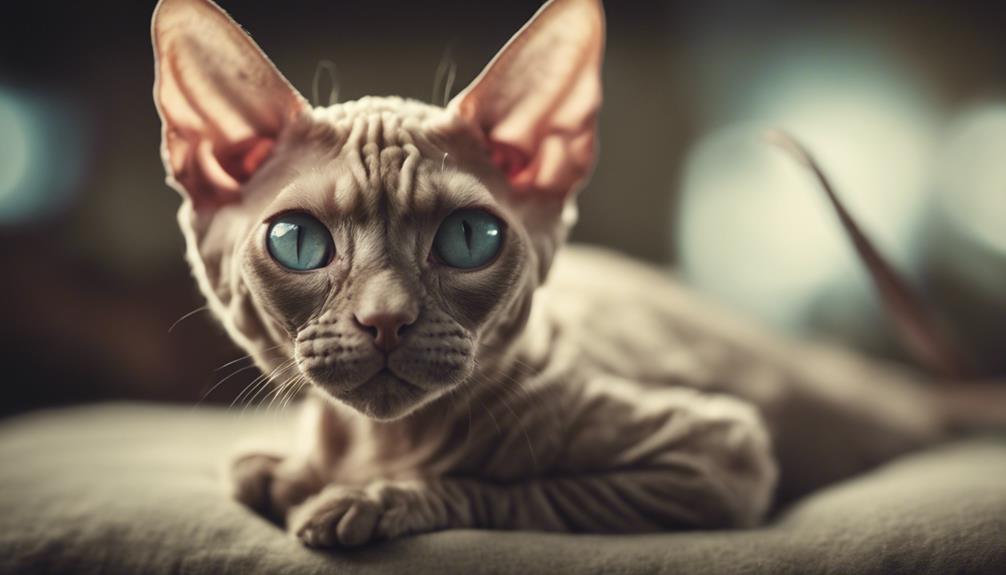
Evolutionarily speaking, the Devon Rex breed’s unique characteristics stem from a genetic mutation discovered in Devon, England in 1960. This mutation led to significant evolutionary changes, resulting in a blend of feline, canine, and primate features within the breed.
The Devon Rex showcases distinctive traits like tabby-like markings, high energy levels, and intelligence, all of which are indicative of its feline evolution. Additionally, features such as large ears and big eyes are a direct result of its genetic development.
Understanding these evolutionary changes is essential in appreciating the Devon Rex’s appearance and behavior, making it a fascinating subject for those interested in the intricate world of feline genetics and evolution.
Genetic Development of Devon Rex
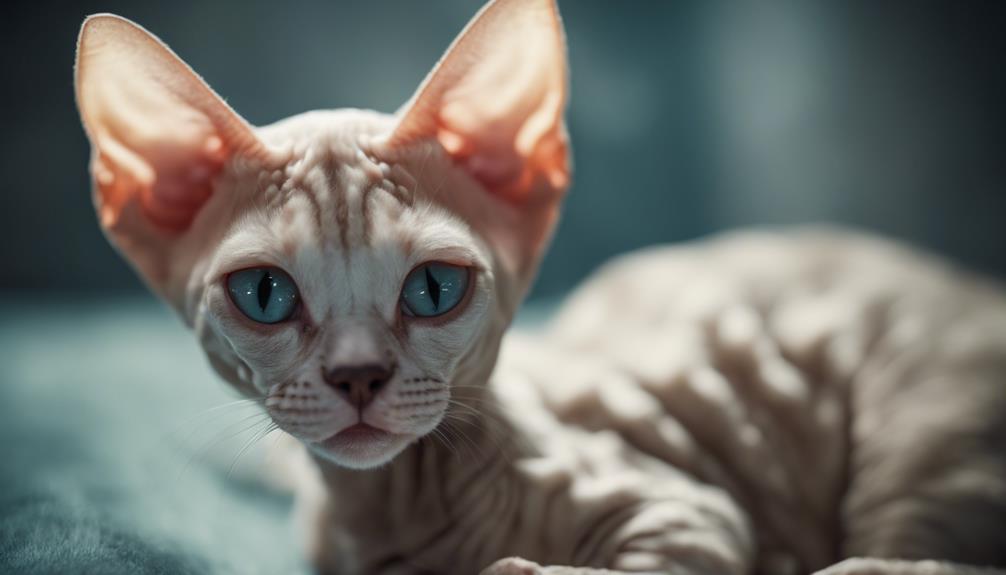
I’ll start by highlighting the pivotal role genetic mutations play in shaping the unique characteristics of the Devon Rex breed.
Through a meticulous breeding selection process, breeders aim to preserve and enhance the distinctive features that define Devon Rex cats.
Understanding the genetic development of Devon Rex sheds light on how specific traits have been refined and maintained over generations.
Genetic Mutations Impact
Through genetic mutations discovered in Devon, England in 1960, the unique characteristics of the Devon Rex breed began to take shape. These mutations led to the development of distinctive features such as large ears, big eyes, and a lanky appearance. The genetic evolution also brought about tabby-like markings, high energy levels, and exceptional intelligence in the Devon Rex breed. Understanding the impact of these genetic mutations is crucial for comprehending the breed’s fascinating traits and behaviors.
The blend of these genetic variations not only created a visually striking appearance but also contributed to the breed’s playful nature and high level of intelligence. This genetic journey showcases the beauty and complexity of the Devon Rex breed’s evolution.
- The genetic mutations that shaped the Devon Rex breed evoke a sense of wonder at nature’s intricate design.
- Discovering the origins of the large ears and big eyes in the Devon Rex sparks curiosity about the breed’s unique genetic makeup.
- The interplay of genetic factors influencing the high energy levels and exceptional intelligence of the Devon Rex prompts admiration for the breed’s innate abilities.
Breeding Selection Process
The meticulous breeding selection process for the genetic development of Devon Rex involved a strategic focus on cats exhibiting unique curly coats and distinct physical features like large eyes, low-set ears, and elfish faces. Breeders carefully selected individuals with these traits to maintain and enhance the breed’s characteristics. Introducing new genetic lines was vital in improving and refining the breed standards over time. Through continuous monitoring and selective breeding practices, breeders aimed to preserve the unique qualities of the Devon Rex while ensuring the health and well-being of the cats. Genetic testing played a crucial role in identifying and mitigating potential health issues, contributing to the overall success of the breeding selection process.
| Aspect | Details |
|---|---|
| Curly Coats | Unique trait selected for preservation and enhancement in Devon Rex cats. |
| Physical Features | Large eyes, low-set ears, and elfish faces were key characteristics under focus. |
| Selective Breeding | Continuous practice to refine breed standards and maintain desired traits. |
| Genetic Testing | Significant role in ensuring the health and well-being of the Devon Rex breed. |
| New Genetic Lines | Introduction to enhance desired traits and promote genetic diversity. |
Impact of Selective Breeding on Devon Rex
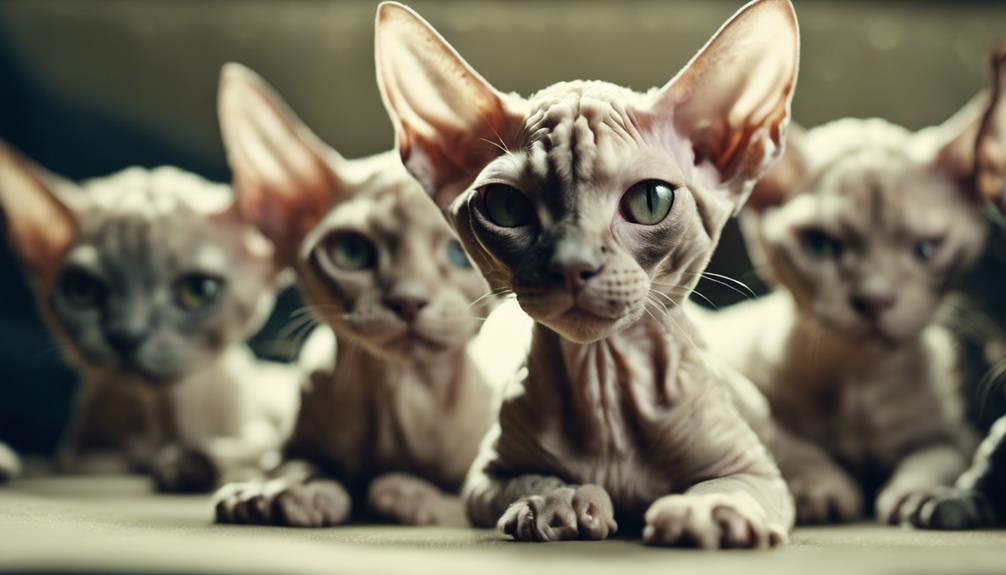
Selective breeding has profoundly shaped the unique physical characteristics that define the Devon Rex breed. Through intentional selection and focused breeding practices, breeders have accentuated traits like the curly coat, large ears, and playful personality that are emblematic of this breed.
The genetic mutation responsible for the distinctive features of the Devon Rex was deliberately chosen and refined over time, showcasing the meticulous efforts behind the breed’s development. The impact of selective breeding on the Devon Rex illustrates the dedication to maintaining specific traits that make this breed instantly recognizable and beloved.
3 Emotional Aspects Elicited:
- Appreciation for the meticulous efforts of breeders in shaping the Devon Rex’s unique characteristics.
- Admiration for the intentional selection that has led to the development of the breed’s defining traits.
- Respect for the dedication to maintaining the distinct features that make the Devon Rex breed stand out.
Notable Milestones in Devon Rex Evolution
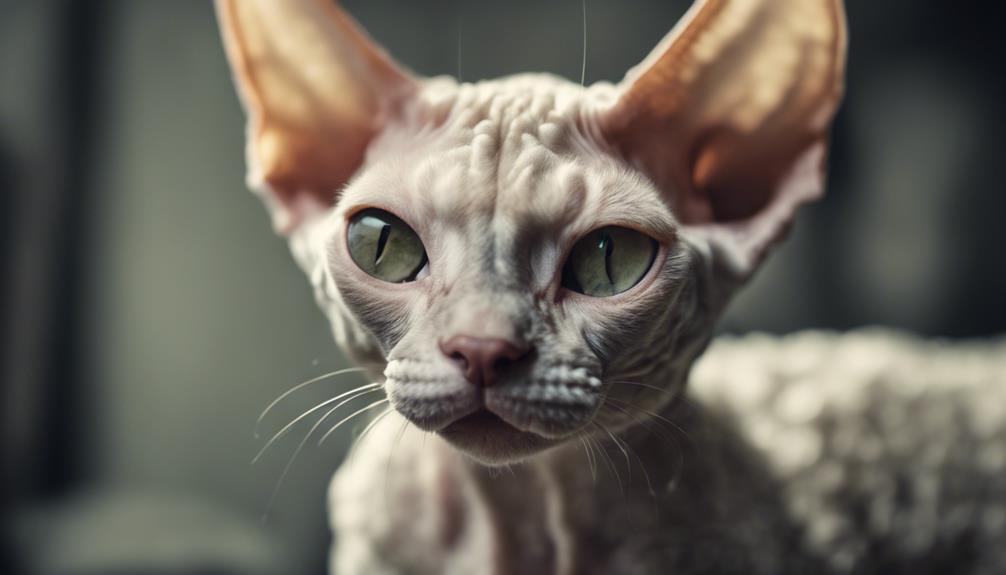
Noteworthy milestones in the evolution of the Devon Rex breed showcase pivotal moments that have shaped their distinctive characteristics and endearing traits.
One significant milestone was the discovery of a genetic mutation in the 1960s in Devon, England, leading to the development of the unique physical features seen in Devon Rex cats today.
Another crucial event was Beryl Cox’s breeding efforts with a feral cat litter, which played a vital role in establishing the breed. These milestones have contributed to the evolution of the Devon Rex’s playful and mischievous personality traits, making them beloved as affectionate companions with intelligent behavior characteristics.
| Milestones | Significance | Impact |
|---|---|---|
| Genetic Mutation Discovery | Initiated unique physical features development in Devon Rex cats | Defined breed’s distinct appearance |
| Beryl Cox’s Breeding Efforts | Established the breed through selective breeding with feral cat litter | Formed the foundation of the Devon Rex breed |
| Evolution of Personality Traits | Shaped playful and intelligent behavior traits in Devon Rex cats | Contributed to their popularity as companions |
Future Trends in Devon Rex Genealogy
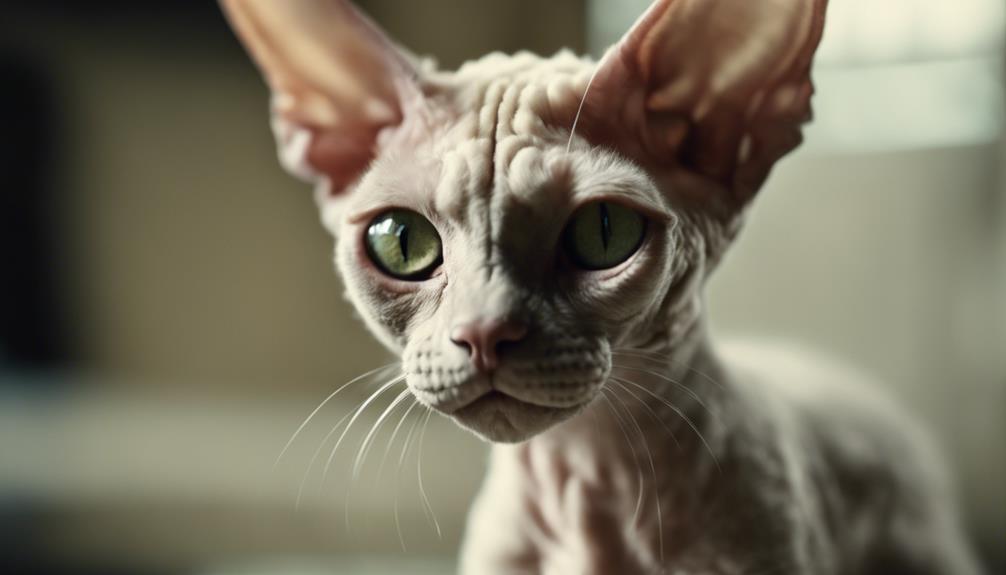
Exploring upcoming trends in Devon Rex genealogy involves delving into genetic testing to identify potential health risks and preserving the breed’s unique physical characteristics through selective breeding.
- Genetic Testing: Utilizing advanced genetic testing methods can help uncover potential health risks within the Devon Rex population, leading to proactive healthcare strategies.
- Selective Breeding: Breeders focusing on maintaining the distinctive physical traits of the Devon Rex through selective breeding practices contribute to the breed’s preservation.
- Genetic Diversity: Studying the genetic mutations and conducting DNA analysis can enhance our understanding of the breed’s ancestry, lineage, and genetic diversity, aiding in informed breeding decisions for the future.
Frequently Asked Questions
What Do I Need to Know About the Devon Rex?
When it comes to the Devon Rex, it’s essential to be aware of their unique coat characteristics, moderate grooming needs, high energy levels, playful demeanor, potential health concerns, specific dietary requirements, training strategies, social tendencies, and exercise regimen.
What Are the Genetic Issues With Devon Rex?
I’ve researched health concerns in Devon Rex. Genetic issues like HCM, patellar luxation, PKD, and myopathy can affect some cats. Responsible breeding, genetic testing, and pedigree analysis are crucial to reduce inherited diseases and ensure genetic diversity.
What Is the Personality of a Female Devon Rex?
As a female Devon Rex, I possess a playful nature, am an affectionate companion, exhibit curious behavior, have social tendencies, am a loyal friend, showcase an energetic personality, am an intelligent companion, display a fun-loving demeanor, and engage in vocal communication.
Why to Not Get a Devon Rex Cat?
Getting a Devon Rex cat may not be ideal due to shedding and allergens, high grooming needs, noise levels, energy demands, behavior challenges, health expenses, and lifestyle compatibility. Considerations include commitments to training, socialization, and space requirements.

